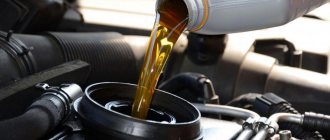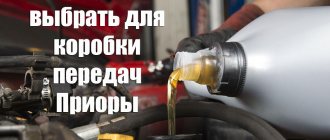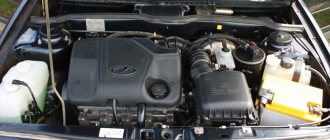It would seem that the answer to the question of how much oil to pour into the engine is the simplest - pour according to the instructions and be done with it. However, everything is not as simple as it seems at first glance. There are a number of dependencies and technicalities that you should be aware of. The question of how much oil to pour into the engine is especially relevant today, when it is time to switch to the summer brand.
The most dangerous thing in this matter is underfilling. Its deficiency leads to oil starvation of the power unit, which entails a high probability of jammed pistons, rotated liners and other serious problems that directly affect the performance of the power unit. Therefore, in addition to getting an answer to the question of how many liters of oil to pour into the engine, you need to constantly monitor the level and it is advisable to carry a spare liter with you just in case. Some drivers rely entirely on the oil pressure sensor indicator, but you should know that when it lights up, in many cases this already indicates a malfunction.
Indeed, you can find out recommendations on the required volume of lubricant for the power unit of a particular car brand in the attached operating instructions. It should be taken into account that the manufacturer indicates the full volume. This means that the technical literature indicates the amount of lubricant required for a freshly assembled motor. As for replacement, its volume should be slightly smaller. The fact is that when replacing, it is impossible to completely drain all the “working off”, because part of it remains in the crankcase, hard-to-reach cavities and on the parts of the power unit. As a rule, about half a liter remains. The conclusion is simple - you do not need to completely fill the entire volume indicated in the manual, but monitor the level using a dipstick or using indicators on the dashboard, which are found in some brands of cars.
How much oil should be poured into the engine if you have an instruction manual is now clear. But if there is no “smart” book, what should you do? In this case, specialized sites can come to the rescue, which you will have to search for, or some expert advice outlined below.
How much oil should be poured into the engine
It is impossible to give a definite answer to this question. Vehicles of different manufacturers and brands have their own lubrication system design. In addition to the crankcase, the oil fluid is located in the pipeline, filter, crankshaft, and other components. How many liters of oil you need to pour into your own engine can be found in the operating manual. This is true when you need to fill the lubricant for the first time. The manufacturer indicates the proper filling rate if the power unit is hollow, just assembled.
After draining the oil solution from the system, some of it remains not drained. This is 300-500 grams of lubricant. It is possible to determine how many liters of oil to pour into a car engine by following the recommendations developed for this. Engines of domestic cars with a volume of 1.8 to 2.4 liters can contain from 3.5 to 4.0 liters of oil fluid. The same imported power units will contain from 4.0 to 4.3 liters of lubricant. To determine how much oil is in the engine, you need to use a dipstick and perform several steps:
- You must initially pour 3.5-3.8 liters of lubricant into the filler neck.
- Wait 2-3 minutes and check the level of the lubricant solution with a dipstick.
- If the value is insufficient, then you need to add 100-200 grams and check the degree of filling again.
The procedure must be repeated until the desired filling level is achieved. When pouring lubricant, you must remember that it is better to add little by little than to immediately overflow. Pumping back the lubricant from the system is a very problematic task. If too much lubricant enters, it will flood the engine parts and components near it. This will lead to foaming of the oil and heavy operation of the power unit. If the filling indicator is less than normal, the rubbing components and parts will quickly wear out.
Selection of petroleum product
Oil volume in a KAMAZ engine
Motors produced today have a high specific power. The operating conditions are quite harsh, so it is necessary to ensure good lubrication of the contacting parts. If the internal combustion engine elements rub against each other, breakdown may occur. The lubricating film greatly increases the service life of engine parts. The main task of motor oil is to reduce friction in the engine. Lubrication costs in the motor must be commensurate with the intensity of its use. There are 3 types of motor oil:
Mineral water is cheap, but in the summer, when it’s hot outside, its viscosity decreases significantly. In winter, mineral oil becomes thicker. Sometimes it becomes so thick that it can no longer pass through the crankshaft oil passages. In this situation, engine parts wear out to the maximum.
Semi-synthetics and synthetics do not depend so much on climatic conditions. In winter conditions, they make it possible to easily start the internal combustion engine. In summer, they retain their own viscosity and form a reliable lubricating film. The disadvantage of synthetics is its rather high cost, so the best option is to purchase a semi-synthetic consumable.
When choosing an oil, it is very important to pay attention to its SAE marking. By deciphering what is written on the canister, it is possible to understand at what temperatures the oil liquid can be used. Knowing the SAE marking can protect you from purchasing the wrong petroleum product.
In the Russian Federation in winter it is best to pour 0w30 or 0w40. In summer, the use of 5w40 is recommended. This oil has technical characteristics that are considered optimal for the Russian winter
Knowing the SAE marking can prevent you from purchasing the wrong petroleum product. In the Russian Federation in winter it is best to pour 0w30 or 0w40. In summer, the use of 5w40 is recommended. This oil has technical characteristics that are considered optimal for the Russian winter.
Determine oil level - methods
To find out the amount of oil in a car engine, several requirements must be met. They are mandatory:
- the car must be placed on a level surface;
- the power unit must be cool. If the check is carried out after stopping the vehicle, then you must wait 15-20 minutes. During this time, the temperature of the starting unit will decrease, the pressure in the lubrication system will drop, and the oil solution will drain into the crankcase;
- The lubricant level must be measured using a standard dipstick.
There are marks on the surface of the probe: min and max. They indicate the minimum and maximum permissible filling volume of oil in a car engine. The process of determining the lubricant level consists of the following points:
- The dipstick must be removed from its regular place and the remaining lubricant must be wiped off with a clean rag.
- Install the measuring rod in its original place.
- Remove the gauge again and inspect the oil layer. It should be located between the min and max marks.
- If the lubricant layer is below the minimum mark, then an oil solution must be added to the lubrication system.
- If the lubricant level is above the maximum mark, excess lubricant must be drained from the system.
Nowadays, almost all cars are equipped with computer warning systems for the presence of oil solution and its consumption. It is not recommended to completely trust computer data. Sometimes, especially before and after a long trip, you need to check the lubricant level in the power plant yourself.
How is the fluid changed?
If you are faced with this task for the first time, here are some tips:
Engine oil drain
- Place the machine on a level surface. The ideal option is a garage pit or overpass.
- Before draining the fluid, drive the car around the city or on the highway for 30-40 minutes so that operating temperature is established inside the engine system.
- Change the oil filter every time you change the oil lubricant.
- Removing old oil is done by unscrewing the oil filler neck at the top of the engine and pulling out the drain plug under the car. The crankcase protection must be removed before replacement.
- It is not recommended to use devices for “express replacement” too often: they do not draw out the entire amount of lubricant, leaving part of the working fluid at the bottom of the unit. As a result, obsolete and new fluids are mixed, which leads to a decrease in engine life.
Intervals when you need to replace
The service book for the vehicle specifies the mileage after which the lubricant solution must be replaced. In the absence of intense operating conditions, driving on the highway outside the city, the mileage between lubricant changes can be up to 15,000 km. Operating vehicles in city traffic will reduce mileage to 9000-11000 km. But these data are not completely accurate, since the condition of the lubricant is influenced by several factors, which include:
- Type and quality condition of the fuel being filled.
- Power plant volume.
- The type of lubricant that was previously filled and its condition.
- The number of hours worked by the engine.
- Technical condition of the vehicle.
- Vehicle operating conditions and power plant operating modes.
These factors can change the quality of the lubricant. Loss of its characteristics by the lubricant will lead to rapid wear of the power plant. In such a situation, an analysis of the oil solution carried out in laboratory conditions can give an accurate answer about the quality of the lubricant and the need to replace it.
The need for replacement according to engine hours
The initial data is the stable average speed of the vehicle in the city and the manufacturer's recommendations for changing the lubricant. Let's say the speed in the city is 40 km/h, and the factory recommendations for replacement are 15,000 km.
To calculate engine hours, you need to divide the distance by the speed limit. In this situation, 15000/40=375 m/h. The obtained value means that after 375 operating hours of the power plant it is necessary to change the oil.
The API international standard has developed a summary table for replacing oils, depending on their type and service life.
| Type of oil solution | Operating hours |
| Mineral | 130-150 |
| SyntheticARI SJ/SHAPI SL/SMPolyalphaolefinsEsters | 230-250320-350370-400430-450 |
| Semi-synthetic | 230-250 |
Need for replacement due to fuel consumption
The initial data should be fuel consumption per 100 km of movement according to passport data and actual. For example, according to the passport, consumption is 9 liters per 100 km, but the actual consumption is 11 liters. According to the passport, the oil change should be carried out every 15,000 km of vehicle movement.
Fuel consumption is calculated using the proportional method for passport and actual data separately. For passport data: 15000x9/100=1350 liters. For actual data: 15000x11/100=1650 liters.
The actual distance through which new oil must be filled is calculated by a similar proportion: 1350x15000/1650= 12270 km.
Each method can be used for any vehicle. It is only necessary to record the data at the moment of pouring lubricant into the motor.
Let's sum it up
In order to determine how much oil to pour into a car engine, you must follow several recommendations:
- Choose a car oil for the vehicle that will be constant throughout its operation. The lubricant must be selected taking into account the operating conditions of the vehicle.
- If the vehicle is actively used, check the oil fill level using a dipstick at least once every 3-4 days.
- Monitor the interval between runs when replacing the lubricant.
- Fill the engine with lubricant in accordance with technology. Do not underfill or overfill the solution.
- If you lack experience, knowledge or doubt, contact a service station that has the necessary equipment. Specialists will carry out the necessary work on the engine, regardless of whether it is diesel or gasoline.
Compliance with the recommendations guarantees long-term operation of the power unit.
Step-by-step instruction
To change the oil in the Gazelle 405 yourself, you should follow the instructions and follow generally accepted safety rules.
The engine is first warmed up to operating temperatures. This is necessary in order to give the lubricant the desired fluidity. This way it will be able to fully exit the crankcase when drained.
It is enough to drive a few kilometers or run the engine at idle speed for 5–10 minutes. When the car is warmed up, start working.
- Remove the negative terminal from the battery, place chocks under the wheels, and securely fix the car if you are working with a jack. Personal safety should never be forgotten.
- The engine oil sump is located under the bottom of the car. It has a drain plug, to remove which you will need a 24 mm wrench.
- Place an empty container under the drain hole where the old used oil will be drained. About 6 liters should come out, so initially take a container of a suitable volume. On a warm engine, the oil leaves the system in 5 - 7 minutes. If it is thicker, it is better to wait 10 - 15 minutes. When the oil has drained, screw the drain plug back on. Make sure it is not deformed or worn. Otherwise, replacement is required.
- The oil filter on the 405 Gazelle is not located in the most convenient place. Therefore, it will be easier for you to work if you remove the engine splash guard. Some try to dismantle the filter through the engine compartment, but to do this you need to have unique dexterity and resourcefulness. Don’t create unnecessary problems for yourself, remove the splash guard and dismantle the filter.
- Sometimes the filter is tightly tightened, making it impossible to remove it manually. Use a special puller. If it is not available, use a long and strong screwdriver or similar tools, pierce through the old filter and turn it, using the screwdriver as a lever.
- Remove the new filter from the box. Pour a small amount of lubricant inside its body. Also lubricate the sealing gasket of the filter device. The filter should be filled with oil to approximately 50% of its volume.
- The filter can only be tightened by hand. You should not use a puller or other tools. Otherwise, there is a risk of damaging the device. Tighten until the filter gasket makes contact with the cylinder block. After this, hand tighten the element 3/4 turn. This is enough for the device to fit tightly into place and not cause oil leakage.
- When all the work under the car is completed, go to the engine compartment of your Gazelle 405. Unscrew the filler plug, insert a funnel into the hole and fill in the required amount of oil.
- Check the level with a dipstick, waiting a few minutes after filling. Close the filler hole and replace the splash guard.
- Start the Gazelle 405 engine, let it idle for several minutes. At the same time, check that there is no fresh puddle of oil under the engine oil sump or signs of leakage. If there are any, tighten poorly sealed connections. Oil may be leaking through the drain hole or filter.
- Stop the engine. Wait 5 - 7 minutes for all the oil to drain back into the crankcase. Now reinsert the dipstick and check the level. If the dipstick shows low oil, add the required amount.
This completes the work of independently replacing the engine lubricant on the Gazelle 405 car. This is a fairly simple procedure that does not require specialized equipment or expensive tools.
Many cite the main difficulties as correct selection of oil and timely change of fluid in the crankcase of the power plant. But now you know all the basic recommendations, and therefore, without any problems, you will be able to purchase high-quality lubricant and maintain the performance of the Gazelle 405 engine.











